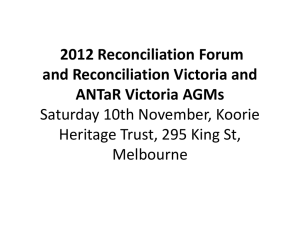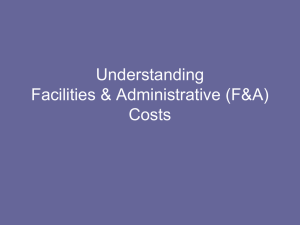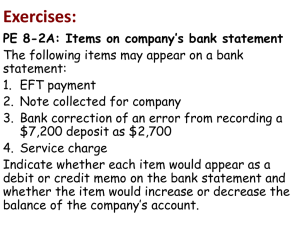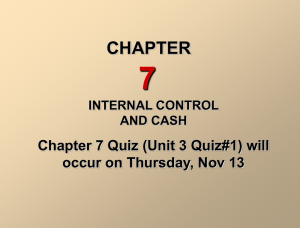National Panchayat Accounting Manual
advertisement
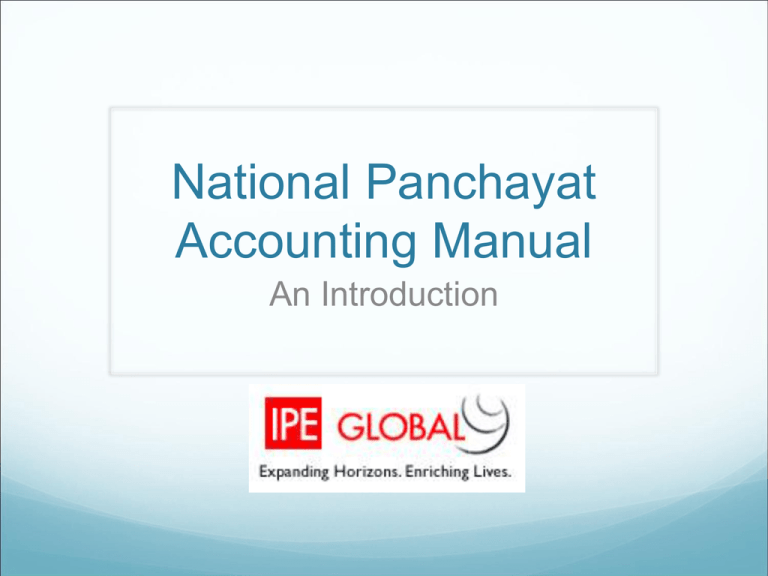
National Panchayat Accounting Manual An Introduction A thought… “The accounts of the government ought to be made as simple as those of the common farmer and capable of being understood by common farmers.” - Thomas Jefferson Accounting Structure Uses simple Three Tier Coding System i.e. Major Head – 4 digits- Represents Functions Minor Head - 3 digits- Represents Programme/Unit Object Head- 2 digits- Represents Object item • Separate 2 digits sub heads have been prescribed for Central Schemes. Accounting Structure S.N Function o. . 1. Minor Irrigation Major Head Receipt Revenue Capita Exp l Exp 0702 2702 4702 Minor Head Description 101 Distt. Panchayat Programm. 2.Example to book expenditure central Scheme NRHM Major Head 2210 –Health Minor Head 101 – Public Health Centre Sub Head – 15 – NRHM Scheme Head Object Head – 02- Wages Accounting Head 2210101-15-02 Basis of Accounting and Accounting Systems Double Entry Single Entry Accrual Basis Cash Basis Proposed Accounting System The Model Accounting System prescribes ‘Cash Based Accounting’. During the various discussions held with stakeholders, there is a general consensus that the accounts should be prepared under Double Entry Accounting system on Cash Basis. Therefore it has been decided that accounts of PRIs will be maintained on ‘Cash Basis’ under ‘Double Entry System.’ Introduction to DEAS Double entry accounting system recognizes that every transaction has a dual affect. There are two sides of every transaction. If one account is debited, any other account must be credited. Every transaction affects at least two accounts in opposite directions. It may, however be noted, that the double entry does not mean that a transaction is recorded twice, but it means that at least two accounts are affected. Introduction to DEAS If PRI purchases a water pipe then its: Bank Account gets reduced. and Assets / stores have been increased Golden Rules of Debit/Credit S.No. Categories of Example Rules of debit and credit Accounts Debit I Personal Credit Persons and Receiver of institutions benefit Giver of benefit Goods, assets What comes including cash in Items relating Expenses / to services i.e salary, wages, Losses rent trade tax etc. What goes account II III Real account Nominal account out Income / Gains Accounting Records & Formats for DEAS The Model Accounting System prescribes 8 formats for maintaining and reporting accounts of the PRIs. Additional books and formats for recording and maintaining basic accounting entries recommended. Under the Double Entry Cash-based accounting PRI shall be required to maintain some Primary/Original Books of Accounts Formats under Model Accounting System Receipt & Payment Account Consolidated Abstract Register Reconciliation Register Statement of Receivable and Payables Register of Immovable Property Register of Movable property Inventory Register Register of Demand, Collection of Balance. Additional Basic Accounting Books & Formats Cash Book PRI 1 Journal Book PRI 2 Ledgers PRI 3 Receipt Voucher PRI 4 Payment Voucher PRI 5 Contra Voucher PRI 6 Journal Voucher PRI 7 DOUBLE ENTRY CASH BASED ACCOUNTING Receipt Payment Deposit / Withdrawal Receipt Voucher Payment Voucher Contra Voucher Adjustments JOURNAL VOUCHER CASH BOOK JOURNAL GENERAL LEDGER TRIAL BALANCE RECEIPTS & PAYMENT ACCOUNT INCOME & EXPEND. ACCOUNT BALANCE SHEET Implementation Through ‘Priasoft’ The End User will only enter any of the following vouchers: Receipt Voucher ( For any money received by PRI Payment Voucher (For any money paid by PRI) Journal Voucher (For making adjustment) Contra Voucher( For withdrawing/depositing cash in Bank) Receipt Vouchers Receipt Vouchers will be passed for following transactions: Any money received on account of income from own sources Funds received as Grants from Central/State/other sources directly or through Transfers from other PRIs Funds received as Advance/Earnest Money/Deposit Funds received on account of recovery of advance given. Cancellation of Stale Cheques( not enchased) Recovery of overpayment if any. Payment Vouchers Payment Vouchers will be passed for following transactions Payments made for Revenue like Salary, Telephone Bills, Electricity Bills etc. Payments made for Capital Expenditure like Construction of Buildings & Infrastructure, Purchase of Vehicles & Machinery etc. Transfer of Funds to other PRIs. Advances given to Employees/contractors/other PRIs Repayment of Advances/Loans and Interest Refund of revenue. Correction in wrong booking of Receipt if separate bank accounts are in operation.. Journal Voucher Journal Voucher are adjustment vouchers and will be passed for non cash transactions like: Correction in source of receipt when the accounts of both the sources are in same Bank Correction in Payment transactions when accounts of both the Payers are in same Bank. Deductions from Payments to be paid to respective authorities later on. Contra Vouchers Contra Vouchers will be entered for followinng transactions: Withdrawing cash from the Bank for making payments in cash. Depositing funds in the Bank received in Cash on accounting of revenue income or EM etc. It may be noted that Contra Voucher shall not be used for transferring funds from one Bank account to another Bank Accounts related to separate schemes. Vouchers to be Passed for different Transactions Nature of Payment Cash withdrawn from bank Property tax received Recovery of Advance (Cash/Cheque) Stale Cheques (issued but not encashed) Grants received form Central/State/Others Salary paid to Gopal Advance given to contractor/employee Transfer of Funds to other PRI Correction in Source of Grant (Same Bank A/c) Correction in Source of Grant (Separate Bank A/cs) Cash deposited in bank Voucher to be Passed Vouchers to be Passed for different Transactions Nature of Payment Voucher to be Passed Cash withdrawn from bank Contra Property tax received Receipt Recovery of Advance (Cash/Cheque) Receipt Stale Cheques (issued but not encashed) Receipt Grants received form Central/State/Others Receipt Salary paid to Gopal Payment Advance given to contractor/employee Payment Transfer of Funds to other PRI Payment Correction in Source of Grant (Same Bank A/c) Journal Correction in Source of Grant (Separate Bank A/cs) Payment /Wrong Source Receipt correct/Source Cash deposited in bank Contra Reconciliation Procedure a. b. c. d. e. f. g. h. Bank Reconciliation Reconciliation of Deposits Reconciliation of receivables & collections Reconciliation of Advances Reconciliation of Loans Reconciliation of Payables (contractor’s) Reconciliation of balances with Government and other agencies. Reconciliation of Ledgers with Subsidiary Ledgers Bank Reconciliation Need of Bank Reconciliation Statement Pin pointing mistakes in the Bank Book maintained by the PRI and Pass Book of the concerned Bank. Identifying delay in the clearance of cheques / remittances Checking on embezzlement Checking the accuracy of Bank Book. Accounting for Bank charges levied by the Bank and Credit of interest given by Bank. Bank Reconciliation Causes Responsible for the Difference Between the Balances of Bank Book and Pass book. Cheques issued by PRIs but not yet presented for payment. Cheques deposited into the bank but not yet collected by the bank. Cheques directly deposited by the customers in PRIs account in the bank. Interest credited by the bank but not recorded in the Bank Book. Interest, bank charges charged by the bank but not recorded in the Bank Book. Dishonored cheques not recorded in the Bank Book. Cheques received and entered in the Bank Book but omitted to be banked. Bank Reconciliation Steps for Preparation of Bank Reconciliation Statement. PRIs may prepare the Bank Reconciliation Statement on monthly basis and should be completed by end of the first week of the next month. Bank reconciliation statement includes the following steps. Firstly tick-out the transactions appearing in both Bank Book and Pass Book / Bank Statement of the relevant month. Secondly list out the transactions of Bank Book and Pass Book which are not ticked-out. Separate list of each of the following is to be prepared. Un-ticked items of receipt side of the Bank Book. Un-ticked items of payment side of the Bank Book. Un-ticked items of deposit column of Pass Book / Bank statement. Un-ticked items of withdrawal column of Pass Book / Bank statement. Bank Reconciliation statement shall be prepared separately for each Bank Bank Reconciliation S.No. Items Amount (Rs.) Plus (+) Minus (-) 1. Balance as per Bank Book √ 2. Cheque issued by ULB but not presented for payment Cheque deposited into bank but not yet collected Cheque directly deposited by the customers in ULBs bank account. Interest credited by the bank but not recorded in bank book Interest / Bank charges / Collection charges debited by the bank but not recorded in the Bank Book Dishonored cheques not recorded in the Bank Book Cheques received and entered in Bank Book but omitted to be banked Total √ √ √ Balance as per bank statement / Pass Book (Difference of plus and minus) Grand Total √ √ 3. 4. 5. 6. 7. 8. √ √ √ √ √ √ Reconciliation of Deposits For reconciliation of Deposits, PRIs will prepare following Statement : Sr. No. Particulars 1. Balance of deposits in the beginning of accounting period. Add – Deposits received during the year. Less – Refund of deposits during the year. Less – Deposits adjusted during the year. Balance of deposit at the end of accounting period. 2. 3. 4. 5. Amount (Rs.) Reconciliation of Receivables and Collections Receivables and collections shall be reconciled on yearly basis or other shorter time intervals as PRI may decide. Receivable on account of taxes, fees and rent should be derived from the respective DCB register. The Reconciliation Statement shall be reconciled with the respective ledger accounts maintained by the PRI. The reasons for differences, if any, shall be identified and rectification entries passed in the department which has recorded the entry incorrectly Reconciliation of Advances Reconciliation of advance given to Contractors/Suppliers The PRI shall maintain a record of the advances given to each of the contractors/suppliers. The PRI who has given advance to the contractor/supplier shall prepare a Reconciliation Statement of Advance Outstanding in the format provided in Table below for all the contractors/suppliers. In case there is a discrepancy between the records this statement may have to be prepared for each contractor/supplier. Following Table can be used for Reconciliation of Advances given: Reconciliation of Advances Particulars Amount (Rs.) Advance outstanding at the beginning of the accounting year Add: Further advance given during the current accounting year (specify all the Payment Orders through which advance have been provided) Total Advance Provided Less: Advance recovered during the current accounting year (specify all the Statement of Collection through which advance had been recovered) Less : Advance Adjusted (Give details) Advance outstanding accounting period at the end of the Reconciliation of Advances For reconciliation of advances given to employees, following Table can be used: Particulars Advance outstanding at the beginning of the accounting year Add: Further advance given during the current accounting year (specify all the Payment Orders through which advance have been provided/replenished) Total Advance Provided Less: Advance recovered including recovery from the salary during the current accounting year Advance outstanding at the end of the accounting period Amount (Rs.) Reconciliation of Loans The PRI shall maintain a record of all the loans borrowed in Register of Loan (Form PRI- 29). At the end of each accounting year, the PRI shall prepare and forward to the lender, a Confirmation Statement for loan borrowed in the format provided in Table below stating therein, the amount borrowed or disbursed directly to Executing Agency, the amount repaid and interest accrued and paid on the loan Reconciliation of Loan Particulars Loan outstanding at the beginning of the accounting year Add: Instalments received during the accounting year Sub-total loan outstanding Less: Instalments paid during the accounting year Net Loan outstanding at the end of the accounting year (A) Total Interest Payable at the beginning of the accounting year Add: Interest accrued during the accounting year Total Interest Payable Less: Interest paid during the accounting year Total Interest Payable at the end of the accounting year (B) Total amount due (principal plus interest) at the end of the accounting year (A+B) Amount (Rs.) Amount (Rs.) Reconciliation of Payables Sr. No. Particulars A OPENING BALANCE OF UNPAID BILLS i. Bill outstanding in respect of the previous accounting year ii. Bill outstanding in respect of years prior to previous accounting year (This detail should be given year-wise, wherever applicable) B Add: Bills received during the current period C GROSS TOTAL LIABILITY OUTSTANDING (A + B) D PAYMENTS DURING THE CURRENT PERIOD i. Payment of bills pertaining to the current accounting year ii. Payment of bills pertaining to previous year accounting year during the current period iii. Payment of bills pertaining to prior to the previous accounting years during the current period (This detail should be given year-wise, wherever applicable) E Total payments during the current period (i + ii + iii) F CLOSING BALANCE OF UNPAID BILLS i. Bill outstanding in respect of the current accounting year [B – D(i)] ii. Bill outstanding in respect of the previous accounting year [A(i) – D(ii)] iii. Bill outstanding in respect of years prior to the previous accounting year (This detail should be given year-wise, wherever applicable) [A(ii) – D(iii)] Amount (Rs.) Amount (Rs.) Reconciliation of Balances with the Government and Other Agencies Since PRIs are implementing various Central /State government schemes it becomes imperative to reconcile the balances between the books of account of the PRI and the government/agencies. At the end of each accounting year, the PRI shall prepare and forward to the concerned authority/agency within 15 days from the end of the accounting year, a Confirmation Statement stating therein the amount receivable from the authority/agency. the amount payable to the authority/agency . depending on whether sum is receivable from or payable to the authority/agency. Next Step A user friendly Training Manual is being prepared for implementation of National Panchayat Accounting Manual through Priasoft. Thank You www.ipeglobal.com
